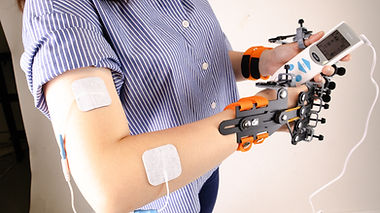
Simulator • Mobility & Dexterity
Geriatric Tremor Simulator
is a unique tool designed to provide users with an immersive experience of tremors i.e. involuntary rhythmic movements that affect the hands, arms, or other parts of the body. This simulator replicates the physical sensations and challenges faced by individuals with tremors, especially on fine motor control, coordination, and daily activities.

What disability or impairment does this simulate?
The Geriatric Tremor Simulator is a unique tool designed to provide users with an immersive experience of a common motor impairment known as tremors. Tremors are involuntary rhythmic movements that affect the hands, arms, or other parts of the body. This simulator replicates the physical sensations and challenges faced by individuals with tremors, offering design students a firsthand understanding of the impact on fine motor control, coordination, and daily activities.
Tremors can be caused by various factors, including neurological conditions, certain medications, or even normal physiological responses. Here are some examples of conditions that can lead to tremors:
1
Essential Tremor:
Essential tremor is one of the most common types of tremor and often runs in families. It typically affects the hands but can also involve the head, voice, or other body parts. Essential tremor is more prevalent with advancing age but can also occur in younger individuals.
2
Parkinson’s Disease:
Parkinson’s disease is a progressive neurological disorder that affects movement. Tremors are a characteristic symptom of Parkinson’s disease, usually appearing as a resting tremor, which means they occur when the affected body part is at rest and diminish with voluntary movement.
3
Multiple Sclerosis:
Multiple sclerosis (MS) is an autoimmune disease that affects the central nervous system. Tremors can occur as a result of MS, typically manifesting as intention tremors, which occur during purposeful movement.
4
Stroke:
A stroke can damage the brain and disrupt its communication with the muscles, leading to tremors. Tremors caused by stroke can vary in type and severity, depending on the location and extent of the brain damage.
5
Medication-induced Tremors:
Certain medications, such as antidepressants, antipsychotics, and asthma medications, can cause tremors as a side effect. These tremors are referred to as drug-induced tremors and may subside or reduce when the medication is adjusted or discontinued.
6
Hyperthyroidism:
Hyperthyroidism, an overactive thyroid gland, can lead to tremors as one of its symptoms. The tremors associated with
hyperthyroidism often affect the hands and may be accompanied by other signs of an overactive thyroid, such as weight loss,
rapid heartbeat, and irritability.
It’s important to note that tremors can occur in various contexts, and their causes can differ. While some tremors may be associated with age-related changes or specific diseases, others may be temporary or reversible.
By using the Geriatric Tremor Simulator as design students, you can gain valuable insights into the experiences of individuals living with tremors, enabling them to develop more inclusive and empathetic designs that cater to the needs of this specific user group.
Warning:
The Geriatric Tremor Simulator is for educational purposes and aims to foster empathy for individuals who experience a tremor. While it simulates some physical limitations, it does not fully replicate the experiences of individuals with a tremor. Use caution to prevent accidents, falls, or strain, and consult a healthcare professional before using the suit, especially if you have pre-existing health conditions. Have a support person present during the simulation.
Disclaimer:
The use of empathy tools does not equal the full experiences of having a disability. It is best to aim to engage with your target audience, using the tools to prepare better. The Geriatric Tremor Simulator is not a substitute for professional advice or comprehensive knowledge of tremors. Consult a qualified healthcare professional for proper medical management and therapy if you have tremors or any medical condition. Use it responsibly, acknowledging limitations and potential risks. The School of Design, the Material Resource Centre, and the creators of this simulator and manual are not liable for any injuries, damages, or misuse of the simulator.
Citation:
If you wish to cite this empathy tools manual, you may insert the reference as follows:
Maximo, T; O’Brien, M; Chan, L.S.; Liu, X.; Zhan, W; Lee, W.K.A. (2024). Empathy Tool Manual: Geriatric Tremor Simulator. School of Design, The Hong Kong Polytechnic University.
PDF manual:
Click here to download the pdf. file (4.3MB)










